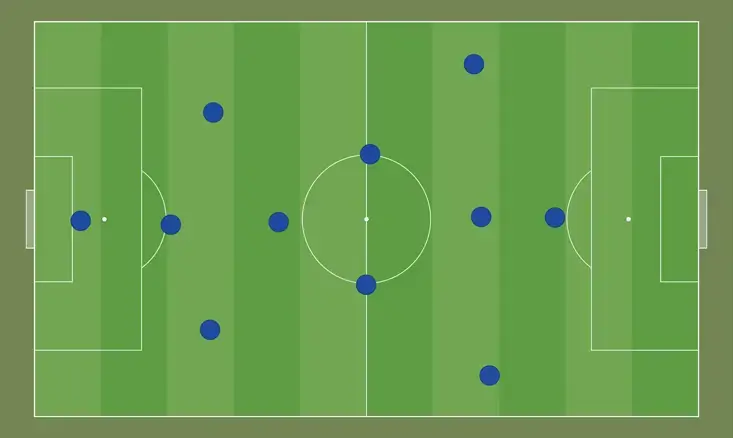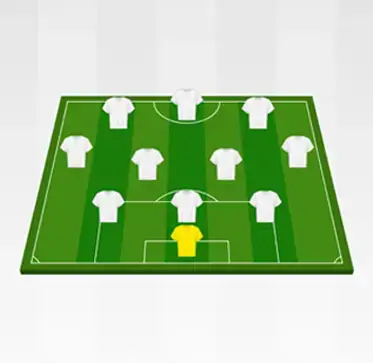CRFC BLOGS
LATEST BLOGS & NEWSLETTERS
A Comprehensive Guide to Youth Soccer 3-4-3 Formation
The youth soccer 3-4-3 formation is a strategic way to organize a soccer team. This formation, characterized by three defenders, four midfielders, and three forwards, is designed to give your team a strong balance between defense and attack. It’s a versatile formation that allows for flexibility on the field, making it a popular choice among coaches who want to teach young players both the basics and the complexities of soccer. In this guide, we’ll explore the strategy behind 3-4-3 youth soccer formation, explain the roles and responsibilities of each player, and discuss the strengths and weaknesses of this formation.
Youth Soccer 3-4-3 Formation and Its Importance
The 3-4-3 youth soccer formation is one of the most balanced formations in soccer. It consists of three defenders responsible for protecting the goal, four midfielders who control the game and support both the defense and the attack, and three forwards who are the primary goal scorers. This formation allows teams to dominate the midfield, which controls the game’s flow.
The youth soccer 3-4-3 formation is particularly effective because it allows for a solid defensive structure while maintaining a potent attack. The three defenders form a solid line at the back, making it difficult for the opposing team to break through. The four midfielders provide defensive cover and attacking support, ensuring the team is always well-balanced. The three forwards are always ready to exploit any gaps in the opponent’s defense, making this formation a constant threat in attack.
Player Responsibilities in Youth Soccer 3-4-3 Formation
Understanding the player responsibilities in the 3-4-3 youth soccer formation is crucial for coaches and players. Each player has a specific role in the formation, and understanding these roles is vital in making the formation work effectively.
Defenders
The three central defenders in the youth soccer 3-4-3 formation are the backbone of the team’s defense. Their primary responsibility is to protect the goal and stop the opponent from scoring. These players must be strong, disciplined, and good at reading the game. They must work together as a unit, communicating constantly to ensure they are always in the correct position.
Though primarily midfielders, the wing-backs also have defensive responsibilities. When the team is defending, they must drop back to help the defenders, providing extra cover on the flanks. This dual role of defending and attacking makes the wing-backs some of the most important players in the 3-4-3 youth soccer formation.
Midfielders
The four midfielders in the 3-4-3 youth soccer formation have a dual role: they must support the defense and the attack. The two central midfielders are the team’s playmakers. They control the game’s tempo, distribute the ball, and support the attack by making late runs into the opponent’s penalty area. These players must have good vision, passing accuracy, and the ability to read the game.
The wing-backs provide width to the attack and support the defense when needed. They must be fast, have good stamina, and deliver accurate crosses into the box. Their ability to transition quickly from defense to attack is crucial to the success of the youth soccer 3-4-3 formation.
Forwards
The three forwards in the youth soccer 3-4-3 formation The central striker is the focal point of the attack. This player must be strong, quick, and have good finishing skills. The two wingers support the central striker by creating space, making runs into the box, and providing crosses.
These forwards must work closely together, often interchanging to confuse the opposing defense and create goal-scoring opportunities. Their ability to work as a unit is crucial to the success of the 3-4-3 youth soccer formation.
Youth Soccer Strategies Using the 3-4-3 Formation
Implementing the youth soccer strategy 3-4-3 requires a clear understanding of defensive and defensive strategies.
Offensive Strategy
In the youth soccer 3-4-3 formation, the offensive strategy revolves around using the three forwards to pressure the opponent’s defense. These forwards should work together constantly to stretch the defense, create space, and take advantage of any defensive lapses. The central striker, often wearing the number 9 jersey, acts as the focal point of the attack. This player must be strong, quick, and have good finishing skills.
The wing-backs play a crucial role in the offensive strategy. They are responsible for providing width to the attack, which helps to stretch the opponent’s defense and create more space for the forwards to exploit. The wing-backs must be fast and have excellent crossing abilities, as they will often deliver the ball into the box for the forwards to attack.
The team’s playmakers are the two central midfielders in the youth soccer 3-4-3 formation. They control the game’s tempo, distribute the ball to the forwards and wing-backs, and support the attack by making late runs into the opponent’s penalty area. These players must have good vision, passing accuracy, and the ability to read the game.
Defensive Strategy
Defensively, the 3-4-3 youth soccer formation is designed to be solid and challenging to break down. The three central defenders form a tight line at the back, protecting the goal and making it difficult for the opponent to find space. These defenders must be strong, disciplined, and have good communication skills to ensure they are always in the correct position.
The wing-backs in the youth soccer 3-4-3 formation also have essential defensive responsibilities. When the team is defending, the wing-backs must drop back to help the defenders, effectively turning the formation into a 5-4-1 or 5-3-2. This gives the team extra defensive cover, making it even harder for the opponent to score.
The two central midfielders in the 3-4-3 youth soccer formation also play a crucial role in defense. They must drop back to shield the defenders, break up the opponent’s attacks, and win the ball back for their team. This dual role of supporting defense and attack makes the central midfielders some of the most critical players in the formation.

Strengths and Weaknesses of the Youth Soccer 3-4-3 Formation
Every formation has pros and cons, and the youth soccer 3-4-3 formation is no exception. Understanding its strengths and weaknesses is key to using it effectively.
Strengths
Balanced Approach
The youth soccer 3-4-3 formation offers a good balance between attack and defense. With three defenders at the back, the team is well-protected against counter-attacks. The four midfielders provide defensive cover and attacking support, ensuring the team is always well-balanced.
Midfield Dominance
The four midfielders in the 3-4-3 youth soccer formation can dominate the central areas of the field, making it difficult for the opponent to control the game. This midfield dominance allows the team to maintain the game’s tempo, dictate play, and create scoring opportunities.
Flexibility
The youth soccer 3-4-3 formation is highly adaptable. Depending on the game’s flow, it can quickly shift to a more defensive or offensive strategy. For example, the wingbacks can drop back to form a five-man defense when needed or push forward to provide extra attacking support.
Weaknesses
Vulnerability to Wide Attacks
One fundamental weakness of the 3-4-3 youth soccer formation is its susceptibility to broad attacks. If the wing-backs are caught too high up the pitch, the team can be vulnerable to counter-attacks down the flanks.
High Physical Demands
The youth soccer 3-4-3 formation places high physical demands on the wing-backs. These players need to cover a lot of ground to support the defense and the attack. This requires high levels of stamina, speed, and discipline.
Complexity for Young Players
The youth soccer 3-4-3 formation can be complex for younger players to grasp. It requires good decision-making, positional awareness, and the ability to transition quickly between defense and attack. Coaches must spend time teaching these concepts and ensuring players understand their roles.
Drills and Training for the Youth Soccer 3-4-3 Formation
To effectively implement the youth soccer 3-4-3 formation, coaches need to focus on specific drills that address the unique demands of this formation. These 3-4-3 youth soccer formation drills will help players become more comfortable with their roles and responsibilities, leading to better team performance.
Defensive Drills
Communication Drills
The three central defenders must work together as a unit, communicating constantly to ensure they are always in the right position. Youth soccer defensive drills focusing on communication and positioning will help the defenders develop this crucial skill.
Positioning Drills
The wingbacks need to understand when to push forward and when to drop back to support the defense. Drills that focus on positioning and decision-making will help them learn how to transition effectively between defense and attack.
Midfield Drills
Passing and Movement Drills
The central midfielders in the youth soccer 3-4-3 formation must control the game’s tempo and distribute the ball effectively. Drills focusing on passing accuracy, movement off the ball, and vision will help these players develop the skills they need to succeed.
Wing-Back Drills
The wing-backs must be fast, have good stamina, and deliver accurate crosses into the box. Drills focusing on speed, crossing, and stamina will help the wing-backs develop the skills they need to perform their dual role in the formation.
Offensive Drills
Shooting Drills
The team’s primary goal scorers are the three forwards in the youth soccer 3-4-3 formation. Drills focusing on shooting accuracy, finishing, and ball movement will help these players become more effective in front of the goal.
Combination Play Drills
The forwards and midfielders need to work together to create goal-scoring opportunities. Drills focusing on combination play, such as one-twos, give-and-goes, and overlapping runs, will help the players develop the understanding and teamwork needed to break down the opponent’s defense.

Conclusion
The youth soccer 3-4-3 formation offers a balanced approach to defense and attack, making it versatile and effective for young players. By understanding the 3-4-3 youth soccer formation player responsibilities and regularly practicing the 3-4-3 youth soccer formation drills, young players can learn valuable skills that will benefit their overall development.
Join our Upcoming Seasons and Camps to learn and practice youth soccer formations.
FAQs
What are the main advantages of using the 3-4-3 formation in youth soccer?
The 3-4-3 formation offers a balanced approach between defense and attack, making it ideal for youth teams. It allows for midfield dominance, flexibility in adapting to different game situations, and solid defensive coverage with three central defenders. This formation also encourages teamwork and helps young players better understand their roles on the field.
How do you effectively coach the 3-4-3 formation to youth soccer players?
Coaching the 3-4-3 formation requires focusing on drills that emphasize communication, positioning, and understanding player responsibilities. Start by explaining the roles of each position and how they work together as a unit. Use specific drills to practice defensive cohesion, midfield control, and offensive movement.
What are the typical weaknesses of the 3-4-3 formation in youth soccer?
The 3-4-3 formation can be vulnerable to wide attacks if the wingbacks are caught too far up the field. It also places high physical demands on the wingbacks, requiring them to cover much ground.
What are the best drills to improve player performance in the 3-4-3 youth soccer formation?
To improve performance in the 3-4-3 formation, focus on drills that enhance communication among defenders, passing and movement for midfielders, and finishing for forwards. Specific drills like defensive shape exercises, wing-back crossing drills, and combination play practices are essential. Regularly practicing these drills will help players become more comfortable and practical in their roles within the 3-4-3 formation.
How do you ensure players understand their roles in the 3-4-3 youth soccer formation?
Providing clear and consistent instruction is essential to help players understand their roles in the 3-4-3 formation. Use visual aids like diagrams and videos to illustrate the formation and each player’s position. During practice, break down the formation into small-sided games focusing on specific areas, such as defense, midfield control, and attacking. Regular feedback during training sessions will help players understand their responsibilities and improve their overall performance in the formation.

Did you find this useful?


